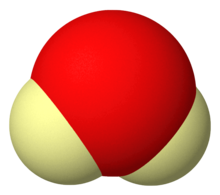Tritiated water
This article needs additional citations for verification. (May 2013) |
 | |
 | |
| Names | |
|---|---|
| IUPAC name
[3H]2-water
| |
| Systematic IUPAC name
(3H2)Water | |
Other names
| |
| Identifiers | |
3D model (JSmol)
|
|
| ChEBI | |
| ChemSpider | |
| MeSH | tritium+oxide |
PubChem CID
|
|
CompTox Dashboard (EPA)
|
|
| |
| |
| Properties | |
| T2O or 3H2O | |
| Molar mass | 22.0315 g·mol−1 |
| Appearance | Colorless liquid[1] |
| Density | 1.21 g/mL |
| Melting point | 4.48 °C (40.06 °F; 277.63 K)[3] |
| Boiling point | 101.51 °C (214.72 °F; 374.66 K) |
| Acidity (pKa) | 15.21[2] |
Except where otherwise noted, data are given for materials in their standard state (at 25 °C [77 °F], 100 kPa).
| |
Tritiated water is a radioactive form of water in which the usual protium atoms are replaced with tritium atoms. In its pure form it may be called tritium oxide (T2O or 3H2O) or super-heavy water. Pure T2O is a colorless liquid,[1] and it is corrosive due to self-radiolysis. Diluted, tritiated water is mainly H2O plus some HTO (3HOH). It is also used as a tracer for water transport studies in life-science research. Furthermore, since it naturally occurs in minute quantities, it can be used to determine the age of various water-based liquids, such as vintage wines.
The name super-heavy water helps distinguish the tritiated material from heavy water, which contains deuterium instead.
Applications
[edit]Tritiated water can be used to measure an organism's total body water (TBW). Unlike doubly labeled water this method relies on scintillation counting. Tritiated water distributes itself into all body compartments relatively quickly. The concentration of tritiated water in urine is assumed to be similar to the concentration of tritiated water in the body. TBW is determined from the following relation:
Health risks
[edit]This section needs additional citations for verification. (September 2023) |
Tritium is radioactive and a low energy beta emitter.
While HTO is produced naturally by cosmic ray interactions in the stratosphere, it is also produced by human activities and can increase local concentrations and be considered an air and water pollutant. Anthropogenic sources of tritiated water include nuclear weapons testing, nuclear power plants, nuclear reprocessing and consumer products such as self-illuminating watches and signs.
HTO has a short biological half-life in the human body of 7 to 14 days, which both reduces the total effects of single-incident ingestion and precludes long-term bioaccumulation of HTO from the environment. The biological half life of tritiated water in the human body, which is a measure of body water turn-over, varies with the season. Studies on the biological half life of occupational radiation workers for free water tritium in a coastal region of Karnataka, India, show that the biological half life in the winter season is twice that of the summer season.
If tritium exposure is suspected or known, drinking uncontaminated water will help replace the tritium from the body. Increasing sweating, urination or breathing can help the body expel water and thereby the tritium contained in it. However, care should be taken that neither dehydration nor a depletion of the body's electrolytes results as the health consequences of those things (particularly in the short term) can be more severe than those of tritium exposure.[citation needed]
References
[edit]- ^ a b "Tritium oxide".
- ^ Perrin, D. D., ed. (1982) [1969]. Ionisation Constants of Inorganic Acids and Bases in Aqueous Solution. IUPAC Chemical Data (2nd ed.). Oxford: Pergamon (published 1984). Entry 252. ISBN 0-08-029214-3. LCCN 82-16524.
- ^ W. M. Jones (1952). "The Triple Point Temperature of Tritium Oxide". Journal of the American Chemical Society. 74 (23): 6065–6066. doi:10.1021/ja01143a070.
- ^ "hydrogen (H) - chemical element". 6 June 2023.
- ^ Paesani, Francesco; Yoo, Soohaeng; Bakker, Huib J.; Xantheas, Sotiris S. (5 August 2010). "Nuclear Quantum Effects in the Reorientation of Water". J. Phys. Chem. Lett. 1 (15): 2316–2321. doi:10.1021/jz100734w.


